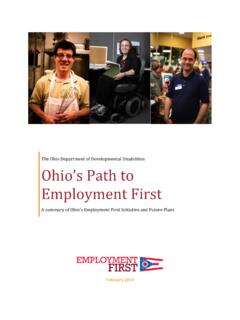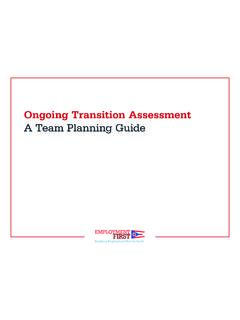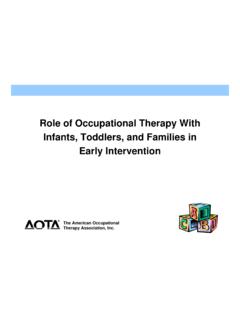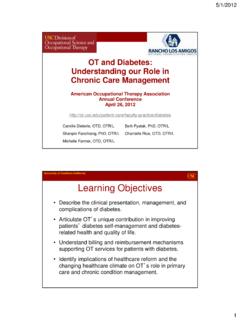Transcription of Occupational Therapists role in supporting Employment
1 1 Occupational Therapists role in supporting Employment Dennis Cleary, MS, OTD, OTR/L The Ohio State University Division of Occupational Therapy After today you will be able the scope of practice of Occupational Therapy in supporting individuals with IDD in Employment . how to access Occupational therapy services in schools and community settings. best practices in Occupational Therapy to support Employment for those with intellectual disabilities. the Occupational Therapy Process to analyze workplace problems. 3 Month Trainings available at website June 30, 2014 Task analysis for job coaches July 21, 2014 Worksite Analysis for job coaches August 28, 2014 Tablet Computers and Smartphones as workplace supports September 23, 2014 the role of the Occupational Therapist in supporting Employment October 27, 2014 the role of Rehab Engineering and the Assistive Technology Center in supporting Employment November 20, 2014 Video Resumes and Professional Portfolios: Presenting Job Seekers in the best light January 26, 2015 Augmentative Communication Devices as Employment supports.
2 February 26, 2015 Employment supports for those with IDD and Autism. March 16, 2015 Employment supports for those with Physical or Sensory involvement. April 28, 2015 The Job Matching Process Previous Presentations: Handouts This Presentation Address list for OT and OTA Programs in Ohio Transitions Checklist (AOTA) OT s Role in Employment of Young Adults 6 Free Occupational Therapy Consultation right type a question for Stacy! Background on Employment About 3% (9 million people) of the American population lives with an intellectual disability (ID)1 Birth 21, IDEA Mandates Total lifetime costs (healthcare, support services, lost productivity) $1 million per individual with ID3 1 Administration on Intellectual and Developmental Disabilities, 2012 2 Newman et al.
3 , 2011; Bureau of Labor Statistics, 2012 3 Centers for Disease Control and Prevention, 2006 Postsecondary Outcomes Intellectual Disabilities All Disabilities General Population Post HS Education 29% 60% 67% Post HS Employment 39% 60% 66% 2 Importance of Employment Work is fundamental to human identity1 Work is closely related to Socioeconomic status 2 Quality of Life,3 and Health 4 Work provides structure to view the world and participate in life 5 1 Corcoran, 2004 2 Butterworth et al., 2012 3 Eggleton et al., 1999 4 Petrovski & Gleeson, 1997 5 Daston, Riehle, & Rutkowski, 2012 Occupational Therapy Has a strong history in Employment (1917) Roots of the profession are in helping soldiers find meaning and develop Employment skills after World Wars I and II You are probably most familiar with our role in the schools, county boards, or in industrial rehabilitation programs (FCEs) What do OTs do?
4 Occupational Therapists prevent illness, remediate disability, and restore health by enabling participation in meaningful occupations Occupations, ..you mean jobs, right? and no! OTs use the term occupation in the following way, occupations are: everyday life, named, organized, and given value and meaning by individuals and a culture. Occupation is everything people do to occupy themselves, to look after themselves or others Areas of Occupation of Daily Living , Education, & Other Productive Activities & Leisure 6400 Occupational Therapists and Occupational Therapy Assistants in Ohio OTR/L or OT/L Occupational Therapist Registered/Licensed BA, MS, MOT.
5 OTD COTA/L or OTA/L OT Assistant Certified/Licensed Two year community college degree The COTA needs to be supervised by an Occupational Therapist to use the COTA credential or bill for OT services OT Graduate School Courses Anatomy Physiology Activity Analysis Neurology Motivation Psychology Assistive Technology Business Lifespan Assessment Prosthetics Supervision Pediatrics Medical Terms Kinesiology Splinting Sensory Systems Orthotics Gerontology Research Wheelchairs Physical Skills Medications Lifestyle Redesign 1100 hours of Supervised Practice National Certification Examination State Licensure Person Environment Occupation Person Occupation Environment Occupational Performance (Teach new skill) (Modify the task) (Adapt) Typical pattern of OT Intervention for someone with IDD over a lifetime Early Intervention Pre-School Grade school Middle School High School Transition Adult Why OT is less involved in Employment handled by others Therapy s role not understand by team of financial resources Kardos, M.
6 , & White, B. P., (2005). the role of the school-based Occupational therapist in secondary education transition planning: A pilot survey study. American Journal of Occupational Therapy, 59, 173-180 Mankey, T. A. (2011). Occupational Therapists ' Beliefs and Involvement with Secondary Transition Planning. Physical & Occupational Therapy In Pediatrics, 31(4) Shattuck, P. T., Wagner, M., Narendorf, S., Sterzing, P., & Hensley, M. (2011). Post high school service use among young adults with an autism spectrum disorder. Archives of pediatrics & adolescent medicine, 165(2), 141-146. O-H-I-O and adapt the environment: Analysis: Increase efficiency building: Technology and tool use, community travel.
7 Living skills training: Cooking, hand washing, dressing, work! skills: Strength, coordination and Sensory motor adaption: Adapt routines, modify environments Approaches used by OT How are OT services delivered? Direct services Evaluation One-on-one, groups Indirect Services (CONSULTATION) Consulting with Job Coach/Individual Worksite Evaluations and recommendations Staff Training Supervision of OT assistant Monitoring progress TeleHealth! Where are services provided? Depends on the site. an Occupational Therapy clinic (depends on state licensure laws) Access to an Occupational Therapist in your setting? Schools Board of Developmental Disabilities Agency -OOD Funding -Waiver Funding -Personal Health Insurance 22 Brown Mackie (Akron) Brown Mackie (Findlay) Cincinnati State Cleveland State Cuyahoga Community EHOVE Adult Career Center Kent State (East Liverpool) Kent State (Ashtabula)
8 Kettering College Marion Technical College North Central State Owens Community Rhodes State College Shawnee State University Sinclair Community College Stark State College The Ohio State University The University of Findlay The University of Toledo Xavier University Zane State College Scarlett OTR, Grey - OTA 23 Why do you need an Occupational Therapist on your team? Best Practices in Occupational Therapy to Support Employment , paid work experience involvement in transition planning on individual s social competence of life skills of assistive technology interdisciplinary and interagency teamwork IDEA, 2013; Lieberman, 2002 Self Determination Self-determined individuals: Demonstrate self-awareness and self-advocacy Make choices and decisions Problem-solve when issues arise Achieve self-identified goals Occupational Therapists work with individuals to improve self-determination and self-advocacy skills by using assessments to make the individual and team aware of strengths, weaknesses, goals and needs, as well as providing direct instruction on how to self-advocate McConnell et al.
9 , 2012; Wagner, Newman, Cameot, Javitz, & Valdes, 2012; Wehman, 2013; Wehmeyer & Shogren, 2013 Emphasis on Social Competence Social competence: individual s effectiveness in navigating interpersonal relationships with others at work, school, home, or in public situations Subjective in nature, and changes given the context Social demands can be complicated and overwhelming for individuals with disabilities, who are less likely to have the opportunities learn, practice, and develop social competence Orsmond, Shattuck, Cooper, Sterzing, & Anderson, 2013; Reichow & Volkmar, 2010 Emphasis on Social Competence Evidence suggests that those with higher level social skills are more likely to be employed Occupational Therapists work with clients to improve their social skills through: instruction Includes training in various communication devices awareness Peer mentoring and positive peer pressure and accommodation climate of integration and encouragement Emphasis on inclusion in businesses and other organizations Test et al.
10 , 2009 Bedesem & Dieker, 2013 Blood et al., 2011 Carter et al., 2012, Alquraini & Gut, 2012, Stanish & Temple, 2012 Bennett & Gallagher, 2013 Development of Life Skills Life skills curriculum is designed to facilitate the development of skills that are necessary for success in adult life; designed as an alternative to traditional academic curriculum Acceptability of this as a valid curricular choice varies due to possible violations of federal guidelines (IDEA 2004, NCLB 2001) Important option for individuals in transition, especially those whose primary target is Employment and not education Considerations for Occupational Therapists individuals must learn and master independent living skills life skills curriculum is a legitimate option curriculum may be more appropriate than an academic curriculum for some individuals of assistive technologies may prove beneficial in promoting independence and can contribute to the functional curriculum Bouck.














